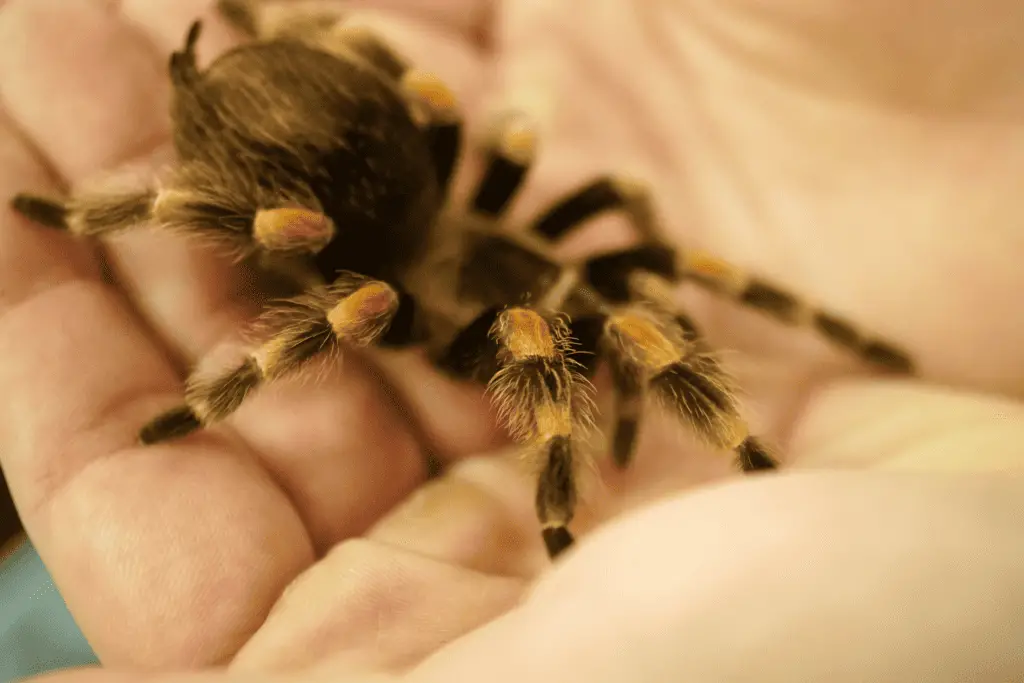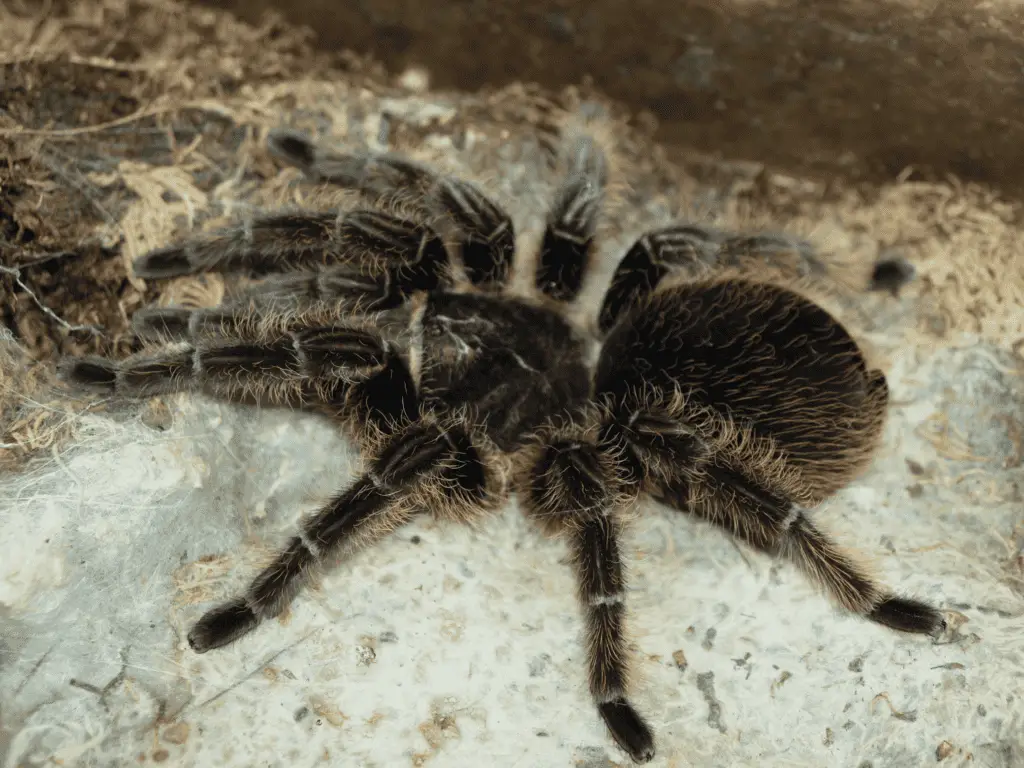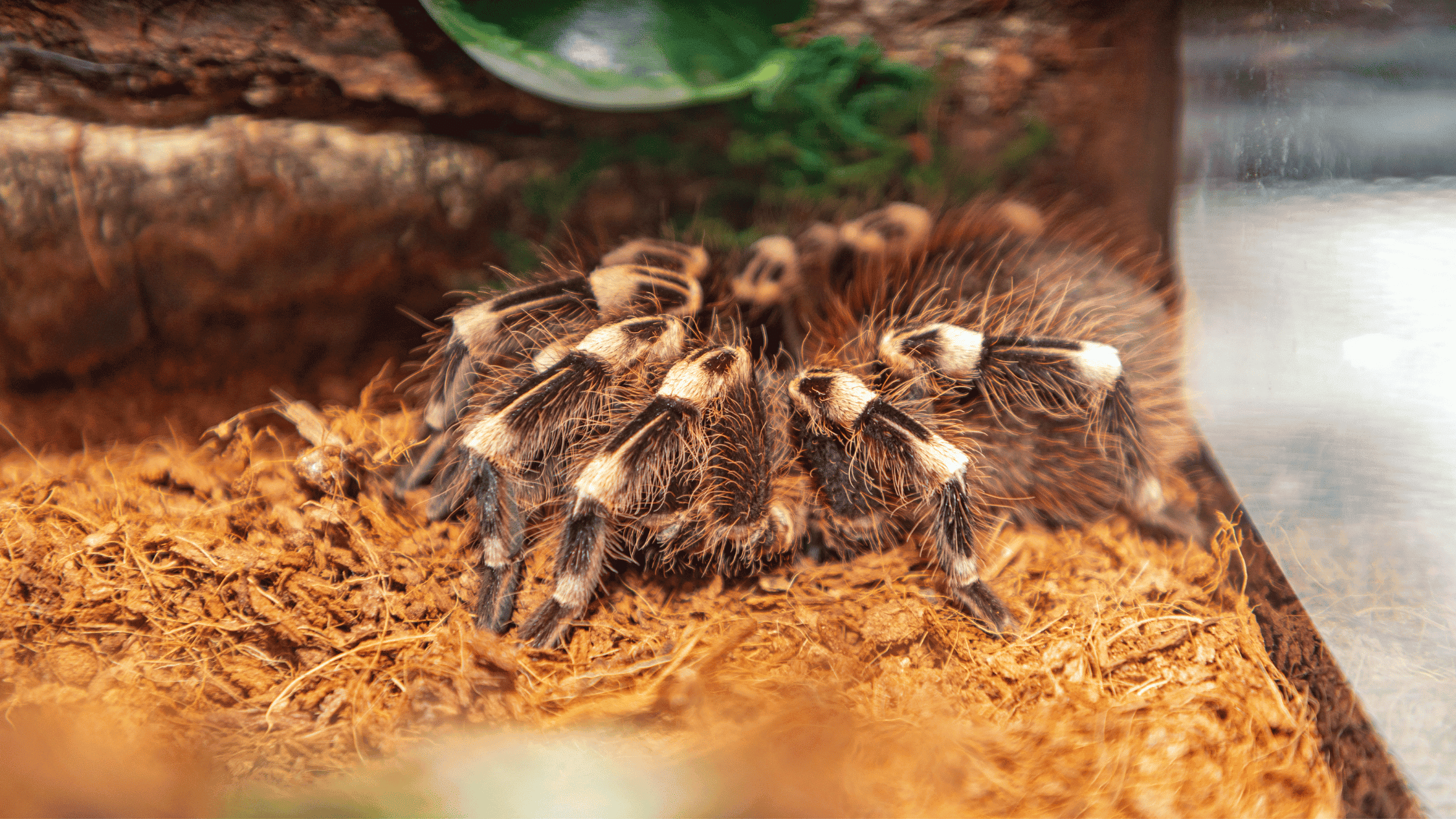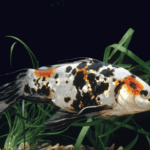Tarantulas, often known for their intimidating size and appearance, are becoming increasingly popular as pets among exotic animal enthusiasts. These fascinating creatures can provide a rewarding and educational experience for their owners, as they boast a wide range of species, each with unique characteristics and care requirements. As you dive into the world of keeping a pet tarantula, it’s essential to arm yourself with knowledge and understanding to ensure these captivating invertebrates thrive in captivity.
Some key factors to consider when caring for your pet tarantula include proper housing and enclosure, diet and feeding, as well as monitoring and managing their molting and growth. Additionally, it’s crucial to understand their handling and behavioral patterns, general health and lifespan, and any breeding or reproduction considerations. Moreover, learning about their geographical distribution and natural habitat can provide invaluable insight into species-specific requirements that influence your pet tarantula’s overall health and well-being.
Key Takeaways
- Choose the right tarantula species, considering factors such as size, appearance, and care requirements.
- Ensure proper housing, diet, and monitoring of molting and growth for a healthy and thriving pet.
- Learn about handling, behavior, health, and species-specific considerations for a successful tarantula-keeping experience.
Popular Pet Tarantula Species
When choosing a pet tarantula, it’s important to consider the various species available. We’ve compiled a list of some of the most popular and beginner-friendly tarantulas, known for their docile nature and striking appearances.
The Chilean Rose (Grammostola rosea), also known as the Rose Hair, is one of the most popular pet tarantulas due to its relatively calm temperament and beautiful red-brown coloration. Native to the deserts of Chile, these spiders are hardy and low-maintenance, making them an excellent choice for beginners.
Another beginner-friendly species is the Mexican Red-Knee (Brachypelma hamorii), named for the vivid red-orange bands on their legs. These striking spiders are known for their docile nature, and while they may be a bit more expensive, their appealing appearance and ease of care make them a popular choice.
The Pink Toe Tarantula (Avicularia avicularia), hailing from the rainforests of Central and South America, has a unique feature: its pink-tipped legs. This arboreal species is known for being more active and visible than many other tarantulas, making for entertaining pets, while still being relatively low-maintenance.
For those who appreciate monochromatic beauty, the Brazilian Black Tarantula (Grammostola pulchra) is a gorgeous choice. With velvety black body and legs, these stunning spiders are prized for their peaceful temperament. They are also relatively fast-growing, which can be appealing to both beginners and more experienced enthusiasts.
Taking care of a Honduran Curly Hair (Tliltocatl albopilosum), sporting distinctive curly hairs on its body, may prove easy since they’re hardy and adapt well to captivity. Another species with a remarkable appearance is the Desert Blonde Tarantula (Aphonopelma chalcodes), known for its golden-brown color and peaceful nature.
Lastly, we have two notable species with vibrant coloration: the Costa Rican Zebra (Aphonopelma seemanni), displaying eye-catching black and white stripes on their legs, and the Pink Zebra Beauty (Eupalaestrus campestratus), clad in soft pink and brown hues. Both of these lovely tarantulas are known for being docile and easy to care for, rounding out our list of popular pet tarantula species.
When selecting a pet tarantula from any of these popular species, be sure to thoroughly research their specific care requirements to ensure they thrive in your care. Remember that we’re dealing with living creatures—respecting and understanding their needs is crucial to fostering a healthy and enjoyable relationship with your new eight-legged friend.

Housing and Enclosure
When it comes to housing our pet tarantula, selecting the appropriate enclosure is crucial. Tarantulas can be either ground dwellers or tree-dwelling species, and their housing requirements will vary accordingly.
For ground-dwelling tarantulas, a shallow enclosure with more floor space is ideal, as they tend to remain on the ground. These species also enjoy burrowing, so providing ample substrate, such as coconut fiber or peat moss, will help them create their little hideaways. On the other hand, tree-dwelling species require taller enclosures with enough vertical space to climb. Adding branches, cork bark, or other climbing structures is necessary to satisfy their arboreal nature.
The enclosure should be well-ventilated but not drafty. Plastic or glass terrariums with screen lids generally work well for both types of tarantulas. Just make sure the openings are small enough to prevent escape. Here is a suggested size for each:
- Ground-dwelling species: A 5-gallon enclosure measuring about 12x12x12 inches (30x30x30 cm) is suitable for most adult tarantulas.
- Tree-dwelling species: A 10-gallon enclosure measuring about 12x12x18 inches (30x30x45 cm) works best for adults.
Regardless of the type of tarantula, it’s essential to avoid overcrowding. Too much clutter can cause stress, reduce mobility, and interfere with their natural behaviors. We also recommend placing a shallow water dish in the enclosure to ensure our pet has access to clean water at all times.
Taking the time to tailor the housing and enclosure needs for our specific tarantula species allows them to thrive and feel secure in their new home.
Related: Pet Jumping Spider: A Comprehensive Care Guide
Diet and Feeding
When it comes to the diet of our pet tarantulas, we must provide them with a diet that closely resembles their natural food preferences. As these creatures are carnivorous, their primary sources of nutrition are various types of insects and other small invertebrates.
Prey: A tarantula’s diet mainly consists of insects such as crickets, mealworms, and roaches. It is essential to feed them live prey as they rely on movement to detect their food. Make sure to offer appropriately-sized insects that match your tarantula’s size.
Crickets: These serve as an excellent food source, providing ample nutrients and protein. Crickets can be easily purchased from pet stores or online. To feed crickets to your tarantula, ensure proper gut-loading, which means feeding the crickets a healthy diet before offering them to your pet. Gut-loading ensures that your tarantula receives all the necessary nutrients.
Mealworms: As another nutritious food option, mealworms are an excellent addition or alternative to crickets. However, mealworms tend to burrow in the substrate and can avoid being eaten, so we recommend using feeding tongs or a dish to offer them to your tarantula.
Roaches: Roaches can also be an excellent source of nutrition for tarantulas. Dubia roaches, in particular, provide a high-quality protein source and are known to have a more balanced calcium to phosphorus ratio. Their hard exoskeleton may be difficult for some tarantulas to digest; only choose this option if your tarantula can handle their tough shells.
Feeding frequency depends on the age and size of our tarantulas. Spiderlings require more frequent feedings, usually every two to three days, while juveniles can manage with feeding once a week, and adult tarantulas do well with weekly or biweekly feedings. We must pay attention to our pet’s behavior and adjust the feeding schedule according to their needs.
It is important to remove any uneaten prey from the enclosure after 24 hours to keep the environment clean and prevent potential harm to your tarantula. Always make sure to provide your pet with a clean water dish for hydration as well. By providing a varied and nutritious diet, we’re ensuring our pet tarantulas thrive in their captive environment.
Molting and Growth
As tarantula owners, we understand the importance of molting and growth in the lives of our eight-legged friends. Tarantulas, like other arthropods, have an exoskeleton that provides support and protection. However, as they grow, their exoskeleton cannot expand, which means they need to shed it regularly. This shedding process is called molting.
During molting, a tarantula forms a new exoskeleton beneath the old one. They will lay on their backs and push themselves out of their old exoskeleton using their legs and body contractions. It’s important not to disturb them during this delicate process, as it can be stressful and potentially harmful.
Molting serves several purposes:
- Allows growth: Tarantulas can increase in size after each molt as they outgrow their previous exoskeleton.
- Regeneration: Damaged or lost limbs can be regenerated through successive molts.
- Rejuvenation: The new exoskeleton is generally cleaner and free from parasites, providing a fresh start for the tarantula.
Typically, younger tarantulas molt more frequently than older ones, as they are growing at a faster rate. It is common for juveniles to molt every few months, while adults may only molt once a year or less. Factors that influence molting frequency include diet, temperature, humidity, and species.
To prepare for molting, tarantulas may exhibit a few signs such as decreased appetite, lethargy, and the formation of a molting mat (a layer of silk they spin on the ground). During this period, it’s crucial to maintain proper humidity levels, as this helps facilitate the molting process and minimize complications.
In conclusion, molting plays a significant role in the health and growth of our pet tarantulas. By understanding the molting process and providing a suitable environment, we can help ensure their well-being throughout their lives.
Handling and Behavior
When it comes to handling our pet tarantulas, we always need to be cautious and patient. Generally, tarantulas can be skittish and defensive creatures, which means that we should be prepared for them to be hesitant when interacting with us. However, some species are known to be more calm and less aggressive, making them suitable for occasional handling.
It’s important to note that tarantulas are low-maintenance pets, but handling them frequently can be stressful for them. As a rule of thumb, we should limit handling to a minimum, only when necessary, such as during tank maintenance or similar situations. When handling, we should avoid sudden movements and loud noises to avoid stressing them out and provoking an aggressive or defensive reaction.
In terms of behavior, some tarantulas are more active than others. We may observe that they like to explore their environment, especially during nighttime as they are nocturnal creatures. We should be aware that some species may display more active behavior, whereas others can be more reserved and calm.
Here are some key points to keep in mind for handling and behavior of pet tarantulas:
- Always be cautious and patient when handling
- Limit the frequency of handling to avoid stress
- Be prepared for skittish or defensive behavior
- Observe individual behavioral patterns to better understand your tarantula
By understanding the natural behavior of our pet tarantulas, we can provide them with the best possible care while ensuring a positive experience for both them and ourselves.

Health and Lifespan
Pet tarantulas are fascinating creatures, and their health and lifespan vary depending on factors including their species, sex, and living conditions. Generally, female tarantulas have a longer lifespan than males, with many living up to 20 years or more while males usually live for around 5 to 10 years.
As with any pet, maintaining a healthy tarantula requires adequate care. We recommend providing a suitable habitat with the appropriate temperature and humidity, as these arachnids thrive in warm environments. It’s important to keep their enclosures clean and well-ventilated, as well as ensuring they receive adequate nutrition. This can help a pet tarantula to reach its full potential in terms of health and longevity.
Regarding venom, tarantulas do possess venomous glands. However, in most species, their venom is comparatively mild, and a bite is often likened to a bee sting in terms of pain and effects. Any reactions typically involve pain, redness, and swelling, which usually subsides. Having said that, it’s essential to treat every tarantula with care and respect, handling them as little as possible to minimize stress and prevent any accidents.
In case of a tarantula bite, it’s vital to follow these steps:
- Clean the bitten area with soap and water.
- Apply an ice pack to reduce swelling.
- Take a pain reliever if needed.
- Consult a medical professional if uncertain or there are severe reactions.
There are many different species of tarantulas available in the pet trade, each with their own unique characteristics. No matter which species you choose, understanding their specific needs and providing the optimal environment will contribute to a healthy, long-lived pet. As tarantula enthusiasts, we believe in offering the best care to these beautiful and intriguing creatures, ensuring their health, happiness, and long lifespans are fostered.
Breeding and Reproduction
Breeding tarantulas can be a fascinating and rewarding experience for pet owners. We must first ensure that we have a pair of sexually mature tarantulas, one male, and one female. Males can be identified by their hooked tibial spurs and bulbous pedipalps, while females have larger and rounder abdomens.
Before attempting to breed, it is important to provide the tarantulas with an optimal habitat that mimics their natural environment. This includes creating a comfortable burrow for each spider, ensuring proper temperature and humidity levels, and maintaining a healthy diet. Providing a suitable space for both tarantulas allows them to become accustomed to their surroundings and can help reduce stress during the breeding process.
When introducing the male and female, we should be cautious and attentive, as female tarantulas can sometimes be aggressive towards the male. Monitoring their interactions closely is essential to preventing any harm to either spider. If the female shows signs of aggression, it may be necessary to separate them and try again at a later time.
Once the tarantulas have successfully mated, the female will lay her eggs in a silk sac, which she then guards and protects. It can take several weeks for the eggs to hatch, and during this time, the mother should be monitored closely but not disturbed. After the eggs hatch, the baby tarantulas, known as spiderlings, will emerge and begin their journey into life.
At this point, we can think about offering these tarantulas for sale to other enthusiasts or breeders. It is essential to research the specific breed of tarantula and understand any unique requirements as this will make the sale process smoother for both buyer and seller. Transparent information about the tarantula’s habitat, diet, and care requirements should be provided to potential buyers to ensure a successful transition to their new homes.
In conclusion, breeding tarantulas can be an exciting and fulfilling experience when done with care and knowledge. By providing optimal conditions, understanding the specific requirements of each breed, and properly caring for both parent and offspring, we can play an important role in the thriving world of tarantula breeding.
Geographical Distribution and Natural Habitat
Pet tarantulas have a diverse geographical distribution, with over 900 species found around the world. Many of these tarantulas are native to South America and Africa, but they can also be found in the United States. As arachnid enthusiasts, we appreciate the many habitats these unique creatures call home.
In South America, tarantulas can be found in various habitats, ranging from arid deserts to tropical rainforests. Some of the most popular pet tarantula species, such as the Chilean rose and Brazilian black tarantulas, reside in this region. Their exotic coloration and ground-dwelling nature make them a favorite among hobbyists.
Africa is another continent with a rich diversity of tarantula species. Here, many tarantulas call the desert and savannah their home. For example, the famed Usambara orange baboon tarantula, with its striking black and orange coloration, is native to East Africa.
In the United States, tarantulas can be found primarily in the southwestern states. The desert-dwelling Arizona blonde tarantula, with its characteristic golden hairs on its carapace, is one such example. These terrestrial arachnids occupy various habitats, ranging from desert scrublands to grasslands.
It’s essential to note that, regardless of their geographical origin, most pet tarantulas require similar care in captivity. They need a stable, safe environment that mimics their natural habitat, usually with substrate, hiding spaces, and adequate humidity. By understanding their origins and the specific needs of each species, we can provide these fascinating creatures with a comfortable and enriching environment in which to thrive.
Species-specific Considerations
When it comes to pet tarantulas, it’s important to consider the unique characteristics of each species. We’ll discuss a few popular species, including the Cobalt Blue, Jumping Spiders, Desert Blond, and South American Red Hair Tarantulas.
Cobalt Blue tarantulas are strikingly beautiful, with their bright blue coloration setting them apart. They are known for their aggressive behavior but are fascinating to observe. Their preferred habitat is to create tunnels and burrows, so providing adequate substrate is essential for their well-being.
Jumping spiders, on the other hand, are not technically tarantulas but are often kept as pets due to their small size and lively demeanor. Known for their exceptional eyesight and agility, these arachnids require a relatively small enclosure with ample opportunities for climbing.
Desert Blond Tarantulas have a more neutral coloration, featuring a blend of tans and browns with hints of pink and orange. Though they can be skittish, they are generally considered to have a docile temperament, making them a great choice for beginners. When setting up their enclosure, ensure proper ventilation and ample substrate for burrowing.
South American Red Hair Tarantulas are easily recognized by their striking red hairs. They are also known for their “velvety” appearance and interesting behavior. While not overly aggressive, they can be defensive, so care must be taken when handling them. A spacious enclosure with a mix of substrate and climbing opportunities is ideal.
In addition to the specific care requirements for each species, there are general considerations that apply to all pet tarantulas. For example, providing a consistent source of water, maintaining proper humidity levels, offering a varied diet, and regularly cleaning the enclosure are all crucial for their well-being. It’s also important to keep in mind that all tarantulas produce silk, which they may use for various purposes, including lining their burrows, creating webbing to capture prey, and communicating with other tarantulas.
Remember to research each species thoroughly before choosing a pet tarantula, as their care requirements may vary. With proper care, these unique and interesting arachnids can make fascinating and rewarding pets.
Selecting and Purchasing a Pet Tarantula
When considering a pet spider, it’s essential to select one that meets your needs and preferences. There are many species of tarantulas available as pets, but some might be more suitable for you than others.
Firstly, it’s crucial to decide whether you’d prefer a ground-dwelling or arboreal tarantula. Ground-dwelling tarantulas tend to be slower-moving and might be easier to handle. A popular option is the Chilean Rose Tarantula, which is widely available in pet stores across the United States. Another great choice for beginners is the Desert Blonde Tarantula, known for its docile nature.
It’s essential to be mindful of the tarantula’s growth rate and cost. Some species can be more expensive than others, particularly those that are rare or fast-growing. However, we believe that investing in a healthy tarantula that suits your needs and experience level is worth the initial expense.
When purchasing a tarantula, ensure you buy from a reputable pet store or breeder. It’s crucial to obtain a care sheet for your chosen species, which will detail information such as the temperature range, humidity levels, and feeding recommendations.
Before bringing your new pet home, be sure to set up its habitat with the appropriate substrate, hideouts, and temperature control. Additionally, be aware of potential health concerns, such as oral nematodes, that can affect tarantulas.
By carefully selecting and purchasing your pet tarantula, you can ensure that you provide them with a comfortable and healthy environment, contributing to an enriching experience for both you and your new eight-legged friend.
Frequently Asked Questions
What is the ideal enclosure for a pet tarantula?
The ideal enclosure for a pet tarantula depends on the species. Generally, we recommend a glass or plastic tank with a secure lid that provides good ventilation. For terrestrial species, the enclosure should be wider than it is tall, while arboreal species will benefit from a taller enclosure. Be sure to include plenty of hiding spots, appropriate substrate, and a shallow water dish.
Which tarantula species are best for beginners?
Beginner-friendly tarantula species include the Mexican Red Knee (Brachypelma hamorii), Chilean Rose (Grammostola rosea), and the Costa Rican Zebra (Aphonopelma seemanni). These species are known for their docile nature, slow growth, and easy care requirements, making them suitable for first-time tarantula owners.
Are tarantulas dangerous or poisonous to humans?
Tarantulas can produce venom, but it is typically not harmful to humans unless an individual has an allergic reaction. Tarantula bites may cause pain, swelling, and redness, similar to a bee sting. However, tarantulas rarely bite humans, and when they do, it is usually in self-defense.
How long do pet tarantulas live?
The lifespan of a pet tarantula varies depending on the species and sex. Males typically live between 3 to 5 years, while females can live up to 20 years or more. Proper care, including providing a suitable environment and diet, is essential for ensuring a long and healthy life for your pet tarantula.
Do tarantulas bite and is it harmful?
Tarantulas can bite if they feel threatened, but such incidents are rare. Bites from most tarantula species are not harmful to humans, with effects similar to a bee sting. However, some species may have more potent venom that could cause more severe symptoms. It is essential to research your tarantula species to understand the potential risks and always handle them with care to avoid bites.
How do I care for my pet tarantula?
Caring for a pet tarantula involves providing a suitable enclosure with appropriate substrate, hiding spots, and a water dish. Temperature and humidity levels should be maintained within species-specific ranges. Feed your tarantula a diet consisting of live invertebrates, such as crickets or roaches, once or twice a week. Proper handling is crucial to minimize stress and avoid bites. Regularly clean the enclosure and monitor your tarantula’s health to ensure a happy and healthy pet.






